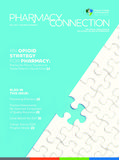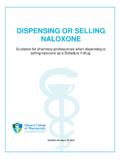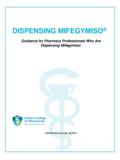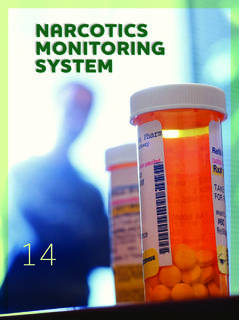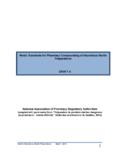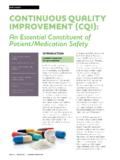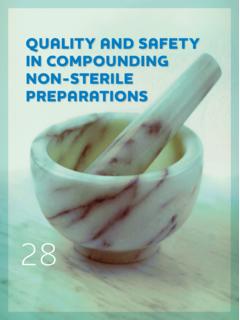Transcription of BUPRENORPHINE Buprenorphine for the …
1 pharmacy CONNECTION ~ WINTER 2014 ~ PAGE 21 BUPRENORPHINEB uprenorphine has been available as a prescription opioid in Canada since 2008. It is marketed as Suboxone by RB Pharmaceuticals in combination with naloxone in a sublingual tablet. In Canada, it is indicated for maintenance treatment of opioid treatment provides an important alternative to methadone maintenance treatment in Canada. It has been shown to be a valuable strategy in helping to address the consequences of the prescription opioid crisis in Ontario, perhaps particularly so in areas where there are few metha-done treatment As with methadone treatment, patients prescribed BUPRENORPHINE should be carefully monitored within a framework of medical, social, and psychosocial support as part of a comprehensive opioid dependence treatment involvement in BUPRENORPHINE treatment can include the supervision of drug administration, monitoring patients, communicating with the treatment team, providing encouragement and support, and dispensing take-home doses ("carries").
2 Involvement in the treatment of opioid -dependent patients with BUPRENORPHINE , has the potential for pharmacists to expand their scope of practice and provides a satisfying professional opportunity to participate in the recovery of individuals dependent on opioids. This area of practice may be of particu-lar interest to those pharmacists already involved in the provision of methadone maintenance treat-ment. opioid dependence is a complex disorder; therefore pharmacists who take training specific to BUPRENORPHINE therapy and other treatment options will be best able to provide pharmacy services to these for the Treatment of opioid DependenceAnne Kalvik, RPh, BScPhmCentre for Addiction and Mental Health, TorontoLeslie Dan Faculty of pharmacy , University of Toronto, TorontoPearl Isaac, RPh, BScPhmCentre for Addiction and Mental Health, TorontoLeslie Dan Faculty of pharmacy , University of Toronto, TorontoLaura Murphy, RPh, BScPhm, PharmDLeslie Dan Faculty of pharmacy , University of Toronto, TorontoToronto Rehabilitation Institute, University Health Network, TorontoEva Janecek, RPh, BScPhmCentre for Addiction and Mental Health, TorontoBeth Sproule, RPh, BScPhm, PharmDCentre for Addiction and Mental Health.
3 TorontoLeslie Dan Faculty of pharmacy , University of Toronto, TorontoUpdated from Winter 2012 PAGE 22 ~ WINTER 2014 ~ pharmacy CONNECTIONBUPRENORPHINEWith BUPRENORPHINE maintenance treatment, as with methadone maintenance treatment, patients benefit from physicians and pharmacists working collaboratively to provide optimal treatment. This includes communicating clinical observations, missed doses, and, in particular now, warnings in response to the Narcotic Monitor-ing System (NMS). Pharmacists need to monitor and manage messages that appear through NMS for patients on BUPRENORPHINE treatment, since alerts may have special significance in this population who have already been diagnosed with a substance use practice guidelines have been developed by the Centre for Addiction and Mental Health (CAMH) to support the initiation, maintenance and discontinua-tion of BUPRENORPHINE /naloxone maintenance treatment in the ambulatory treatment of adults and adolescents with opioid depen-dence in Ontario.
4 The Guidelines3 are available from the CAMH, OCP or CPSO websites, and should be reviewed before dispensing BUPRENORPHINE . ( +guideline+2012/ef7d9c7a-d1b4-46b7-b566- 7207c31ac1b7 )KEY MESSAGES FOR BUPRENORPHINE Suboxone is an opioid prescrip-tion medication containing BUPRENORPHINE 2 mg and 8 mg (in sublingual tablets) in fixed combination with naloxone and 2 mg respectively (to deter injection drug use). Sublingual dissolution of Subox-one tablets usually takes 2 to 10 minutes. BUPRENORPHINE : o is efficacious as maintenance therapy in the treatment of opioid o is an alternative to, but not a substitute for, methadone maintenance o acts primarily as a partial agonist at mu- opioid o is considered safer in overdose than methadone, although if combined with other CNS depressant drugs ( , benzodi-azepines) respiratory depression can If clinical symptoms of overdose occur, higher doses of naloxone or other measures for treatment may be o may have a lower potential for abuse and dependence than pure agonists such as morphine10-11, although abuse does The addition of naloxone to the Suboxone product formulation is intended to further reduce the risk of injecting, but does not eliminate the risk.
5 O can be titrated to a stable dose within days, in contrast to methadone which typically may take weeks to achieve the optimum dose. o prescribed at maximal doses, may not be sufficient for all patients. When the maximum daily dose does not stabilize a patient, consideration should be given to switching to meth-adone. o may induce withdrawal in patients dependent on opioids if administered too soon after last use of full opioid agonists, oxycodone or fentanyl. o has also been successfully used for medical withdrawal treatment (detoxification) from opioids8,13 and for the treatment of pain14 (both are unapproved indications in Canada). REGULATORY FRAMEWORK FOR BUPRENORPHINE BUPRENORPHINE /naloxone does not require a special prescribing exemption, unlike methadone, so prescriptions may be written by any practitioner licensed to prescribe narcotics.
6 The College of Physicians and Surgeons of Ontario (CPSO) advises that they expect all physicians who wish to use BUPRENORPHINE to treat opioid -dependent patients will have training/education on this drug, and addiction medicine generally, prior to initiating BUPRENORPHINE treatment ( ). In addition, the Ontario Drug Benefit LU codes for Suboxone state that prescribers should complete an accredited course on opioid addic-tion and BUPRENORPHINE treatment before for Suboxone have the same requirements as other straight Narcotic Drugs (Schedule N drugs); however, in addition, it is best practice to also indicate: start and stop dates days for supervised administration days for take home dosesAs with other opioids, dispensing procedures for BUPRENORPHINE /naloxone must comply with the Narcotics Safety and Awareness Act, 2010, and requirements of the Narcotics Monitoring Guidelines highly recommend that pharmacists who provide BUPRENORPHINE services undertake training.
7 Pharmacists must be aware of the unique nature of buprenor-phine dispensing and specific issues that exist in dispensing medications for the maintenance treatment of substance dependence. Some training resources are provided at the end of this BUPRENORPHINE WORKS BUPRENORPHINE is a synthetic opioid with a unique profile: it is a partial pharmacy CONNECTION ~ WINTER 2014 ~ PAGE 23 BUPRENORPHINEmu- opioid receptor BUPRENORPHINE has a lower intrinsic activity at the mu- opioid receptor than a full agonist ( methadone or oxycodone). This means that there is a ceiling effect to its opioid agonist effects at higher doses,16 making it safer in overdose and reducing its potential for abuse. There may be little increase in effi-cacy by increasing doses above 16 to 32 mg daily (Note: the maximum approved daily dose for Suboxone in Canada is 24 mg).
8 Although it is a partial agonist, BUPRENORPHINE has a very high affinity for the mu receptor. This tight binding means that BUPRENORPHINE can diminish the effects of other opioid agonists ( methadone or oxycodone). It can precipitate withdrawal in those physically dependent on full opioid agonists by displacing them from opioid The tight binding is also associated with a slow dissociation from the mu receptor resulting in a long duration of This is why buprenor-phine is associated with a milder withdrawal syndrome and has been used to assist in detoxification from other ,13 BUPRENORPHINE s partial mu- opioid agonist activity is beneficial in the treatment of opioid dependence because: It reduces craving for opioids. It may diminish the effects of other opioids ( morphine, oxycodone, heroin).
9 It can attenuate opioid CHARACTERISTICS SPECIFIC TO BUPRENORPHINE17 BUPRENORPHINE s pharmacokinetic properties allow it to be utilized as a feasible maintenance treatment for opioid dependence. BUPRENORPHINE has poor oral bioavailability due to extensive metabolism by intestine and liver. Sublingual administration allows absorption through the oral mucosa and thus prevents break-down via first-pass metabolism. Suboxone tablets are formulated to be dissolved under the tongue. The onset of action is slow, with peak effects from sublingual administration occurring 3 - 4 hours after dosing. BUPRENORPHINE is converted in the liver primarily by cytochrome P450 (CYP) 3A4 to an active metabolite (norbu-prenorphine) with weak intrinsic activity. Both norbuprenorphine and BUPRENORPHINE are subject to hepatic glucuronidation.
10 The mean elimination half-life is indicated as 37 hours in the product monograph2, with evidence in the literature of large inter-individual variation (24 to 69 hours) following sublingual Most of the dose is eliminated in the feces, with approximately 10 30% excreted in slow onset of action and extended duration of action are both desired features in a treat-ment for opioid dependence. It is possible that BUPRENORPHINE can be given on an alternate day or three times weekly dosing schedule once the patient has been stabilized on a daily buprenophine dose. However, this may be a theoretical advantage, since many patients may have difficulty adhering to alternate day schedules and may benefit from daily contact with a ASSESSMENT CONSIDERATIONS opioid dependence in the context being discussed in this article, can be considered the same as addiction which is characterized by a loss of control over opioid use, continued use despite knowledge of harmful consequences, compul-sion to use and/or cravings.
